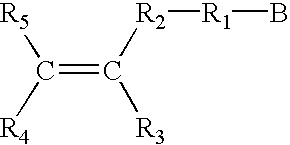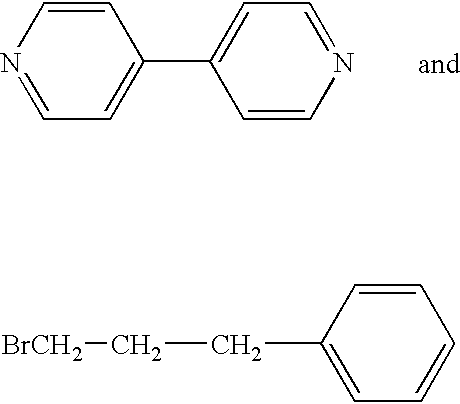Electrochromic layer and devices comprising same
a technology of electrochromic layer and electrode, which is applied in the field of electrochromic layer and devices comprising it, can solve the problems of non-uniform thickness of solution layer, oxidized form of anodic and reduced cathodic electrochromic materials in such devices, and non-uniform thickness in the solution layer
- Summary
- Abstract
- Description
- Claims
- Application Information
AI Technical Summary
Benefits of technology
Problems solved by technology
Method used
Image
Examples
example 1
Synthesis of 1,1′-di(3-phenyl(n-propyl))-4,41-dipyridinium Difluoroborate
[0083]
[0084] The compound was made starting with the known compounds, 4,4′-bipyridine and 1-bromo-3-phenylpropane, of formulas
respectively. A solution of 10 g of 4,4-bipyridine and 38.9 ml of 1-bromo-3-phenylpropane was dissolved in 150 ml of acetonitrile. The solution was refluxed for about 24 hours. The yellow precipitate was filtered off by vacuum filtration. The precipitate was then slurried in an excess of acetone and again vacuum filtered. The yellow precipitate was then dried at 60° C.
[0085] The dried, yellow precipitate was dissolved in 600 ml of warm water and the solution was carbon treated and filtered. To this solution an aqueous solution of sodium fluoroborate was added to provide a slight excess of fluoroborate ions. The solution was heated to about 90° C. and was treated with carbon. The hot solution was filtered and cooled.
[0086] Upon cooling, white crystals and yellow precipitate formed w...
example 2
Electrochromic Layer Comprising a Polymer Matrix from Polyester Polyol Chains Joined by Isocyanates Reacting with Hydroxyls
[0089] An electrochromic layer comprising a polymer matrix made by linking polyester polyol chains through hydroxyl groups of the chains was prepared as follows. 8.0 g of 0.08 M 1,1′-dibenzyl-2,2′,6,6′-tetramethyl-4,4′-bipyridinium difluoroborate in propylene carbonate, 8.0 g 0.08 M 5,10-dihydro-5,10-dimethylphenazine in propylene carbonate, 3.52 g of Desmophen 1700 (a polyester polyol sold by Miles, Inc., Pittsburgh, Pa., USA, made from adipic acid and diethylene glycol, having an average molecular weight of 2550 daltons and an hydroxyl functionality of 2) and 0.48 g of Desmodur N-100 (a polymer of hexamethylene diisocyanate comprising biuret groups, having an isocyanate functionality near 3, sold by Miles Inc.) and one drop of catalyst (dibutyltin dilaurate, Aldrich, Milwaukee, Wis.) were mixed in a glass vial. The electrochromic layer was gelled by baking th...
example 3
Antiscattering Qualities of an Electrochromic Layer Comprising a Polymer Matrix from Polyester Polyol Chains Joined by Isocyanates Reacting with Hydroxyls
[0092] An electrochromic device containing a polyurethane electrochromic layer was prepared as follows. 48.0 g of 0.08 M 1,1′-dibenzyl-2,2′,6,6′-tetramethyl-4,4′-bipyridinium difluoroborate in propylene carbonate, 48.0 g 0.08 M 5,10-dihydro-5,10-dimethylphenazine in propylene carbonate, 21.12 g of Desmophen 1700, 2.88 g of Desmodur N-100, and 2 drops of catalyst (dibutyltin dilaurate, Aldrich, Milwaukee, Wis.) were mixed together and used to fill an electrochromic mirror as detailed in Example 2. Then polymer matrix formation (gelling) was carried out by heating to 85° C. for 25 minutes.
[0093] Adhesive tape was placed on the back of the mirror. A 1 kg metal sphere was dropped on the mirror from a height of approximately 1 m. Inspection revealed that no electrochromic solution had leaked from the broken mirror and there was no evi...
PUM
| Property | Measurement | Unit |
|---|---|---|
| temperature | aaaaa | aaaaa |
| temperature | aaaaa | aaaaa |
| molecular weight | aaaaa | aaaaa |
Abstract
Description
Claims
Application Information
 Login to View More
Login to View More - R&D
- Intellectual Property
- Life Sciences
- Materials
- Tech Scout
- Unparalleled Data Quality
- Higher Quality Content
- 60% Fewer Hallucinations
Browse by: Latest US Patents, China's latest patents, Technical Efficacy Thesaurus, Application Domain, Technology Topic, Popular Technical Reports.
© 2025 PatSnap. All rights reserved.Legal|Privacy policy|Modern Slavery Act Transparency Statement|Sitemap|About US| Contact US: help@patsnap.com



